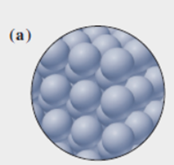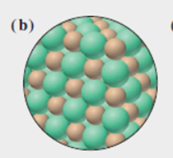
Concept explainers
(a)
Interpretation: To determine the best

Concept Introduction: A pure chemical compound made up of two or even more distinct components whereas A substance would be considered to be an element if no non-nuclear
(b)
Interpretation: To determine the best representation of the element. Compound and mixture.

Concept Introduction: Mixture will be considered as the presence of different kinds of substances.
(c)
Interpretation: To determine the best representation of the element. Compound and mixture.

Concept Introduction: A chemical element or element is any material that cannot be degraded by normal chemical processes into simpler compounds.
Want to see the full answer?
Check out a sample textbook solution
Chapter 2 Solutions
Chemistry: The Molecular Nature of Matter and Change
- The following are properties of substances. Decide whether each is a physical property or a chemical property. a Chlorine gas liquefies at 35C under normal pressure. b Hydrogen burns in chlorine gas. c Bromine melts at 7.2C. d Lithium is a soft, silvery-colored metal. e Iron rusts in an atmosphere of moist air.arrow_forwardA white, crystalline material that looks like table salt gives off a gas when heated under certain conditions. There is no change in the appearance of the solid that remains, but it does not taste the same as it did originally. Was the beginning material an element or a compound? Explain your answer.arrow_forwardDecide whether each of the following is a physical property or a chemical property of the substance. a Salt substitute, potassium chloride, dissolves in water. b Seashells, calcium carbonate, fizz when immersed in vinegar. c The gas hydrogen sulfide smells like rotten eggs. d Fine steel wool (Fe) can be burned in air. e Pure water freezes at 0C.arrow_forward
- Which of the following are compounds, and which are elements? aNa2S bBr2 cPotassium hydroxide dFluorine eCompound or element fCompound or elementarrow_forwardClassify each of the following as (1) a physical property, (2) a physical change, (3) a chemical property, or (4) a chemical change. a. the process of burning a piece of newspaper b. the fact that metallic copper reacts with chlorine gas c. the process of melting ice d. the fact that metallic gold is a solid at room temperaturearrow_forwardAll of the following processes involve a separation of either a mixture into substances or a compound into elements. For each, decide whether a physical process or a chemical reaction is required. a Sodium metal is obtained from the substance sodium chloride. b Iron filings are separated from sand by using a magnet. c Sugar crystals are separated from a sugar syrup by evaporation of water. d Fine crystals of silver chloride are separated from a suspension of the crystals in water. e Copper is produced when zinc metal is placed in a solution of copper(II) sulfate, a compound.arrow_forward
- In the following description of the element bromine, identify which of the properties are chemical and which are physical. Bromine is one of the few elements that is a liquid at room temperature. It is an acrid-smelling substance that reacts readily with most metals. It evaporates easily, so most containers of bromine are filled with visible amounts of red fumes. Most bromine is obtained from sodium bromide, a compound found in salt beds.arrow_forwardA substance X is solid at 25°C. When heated to about 250°C it gradually liquefied. When cooled back to 25°C the liquid could not be induced to solidify. Is substance X probably an element, a compound, or a mixture? Explain your answer.arrow_forwardSilver spoon is an example of Element? Compound? Homogeneous mixture? Hetergeneous mixture?arrow_forward
- _______ is a single kind of matter that cannot be separated into other kinds of matter by any physical means. ______ is a physical combination of two or more pure substances in which each substance retains its own chemical identity. ______ is a pure substance that cannot be broken down into simpler pure substances by chemical means such as a chemical reaction, an electric current, heat, or a beam of light. Can be broken down into constituent elements by chemical, but not physical, means Answer: ______________arrow_forwardTwo beakers contain clear, colorless liquids. When the contents of the beakers are mixed, a white solid is formed. (a) Is this an example of a chemical or a physical change? (b) What would be the most convenient way to separate the newly formed white solid from the liquid mixture— filtration, distillation, or chromatography. Elaborate your answer.arrow_forwardWhile creating a piece of art work, a student becomes curious about the ink he is using to create his art. He wonders if the in is a pure substance or a mixture. The ink appears to be uniform throughout, but separates when a chromatography experimer is performed on it, leaving multiple marks of different colors along the chromatography paper. Using his observations of the properties of the ink, the student can classify it as a heterogeneous mixture. solution. compound. element.arrow_forward
 Introductory Chemistry: An Active Learning Approa...ChemistryISBN:9781305079250Author:Mark S. Cracolice, Ed PetersPublisher:Cengage Learning
Introductory Chemistry: An Active Learning Approa...ChemistryISBN:9781305079250Author:Mark S. Cracolice, Ed PetersPublisher:Cengage Learning World of Chemistry, 3rd editionChemistryISBN:9781133109655Author:Steven S. Zumdahl, Susan L. Zumdahl, Donald J. DeCostePublisher:Brooks / Cole / Cengage Learning
World of Chemistry, 3rd editionChemistryISBN:9781133109655Author:Steven S. Zumdahl, Susan L. Zumdahl, Donald J. DeCostePublisher:Brooks / Cole / Cengage Learning Introduction to General, Organic and BiochemistryChemistryISBN:9781285869759Author:Frederick A. Bettelheim, William H. Brown, Mary K. Campbell, Shawn O. Farrell, Omar TorresPublisher:Cengage Learning
Introduction to General, Organic and BiochemistryChemistryISBN:9781285869759Author:Frederick A. Bettelheim, William H. Brown, Mary K. Campbell, Shawn O. Farrell, Omar TorresPublisher:Cengage Learning Living By Chemistry: First Edition TextbookChemistryISBN:9781559539418Author:Angelica StacyPublisher:MAC HIGHER
Living By Chemistry: First Edition TextbookChemistryISBN:9781559539418Author:Angelica StacyPublisher:MAC HIGHER Chemistry: The Molecular ScienceChemistryISBN:9781285199047Author:John W. Moore, Conrad L. StanitskiPublisher:Cengage Learning
Chemistry: The Molecular ScienceChemistryISBN:9781285199047Author:John W. Moore, Conrad L. StanitskiPublisher:Cengage Learning General, Organic, and Biological ChemistryChemistryISBN:9781285853918Author:H. Stephen StokerPublisher:Cengage Learning
General, Organic, and Biological ChemistryChemistryISBN:9781285853918Author:H. Stephen StokerPublisher:Cengage Learning





